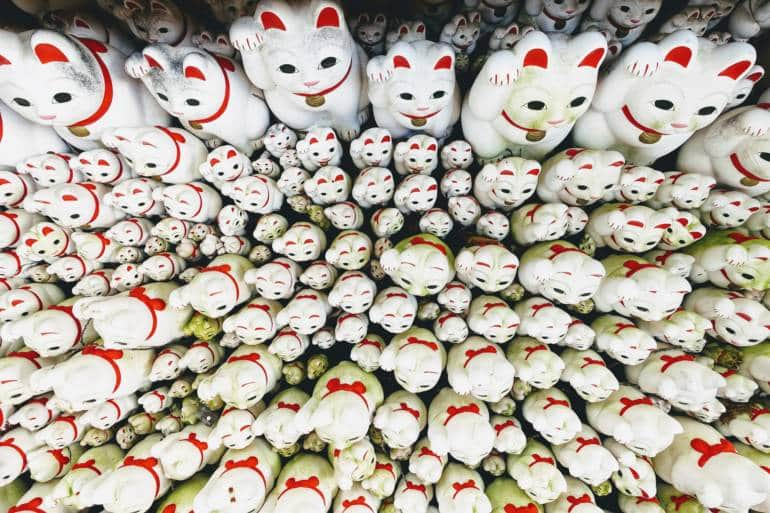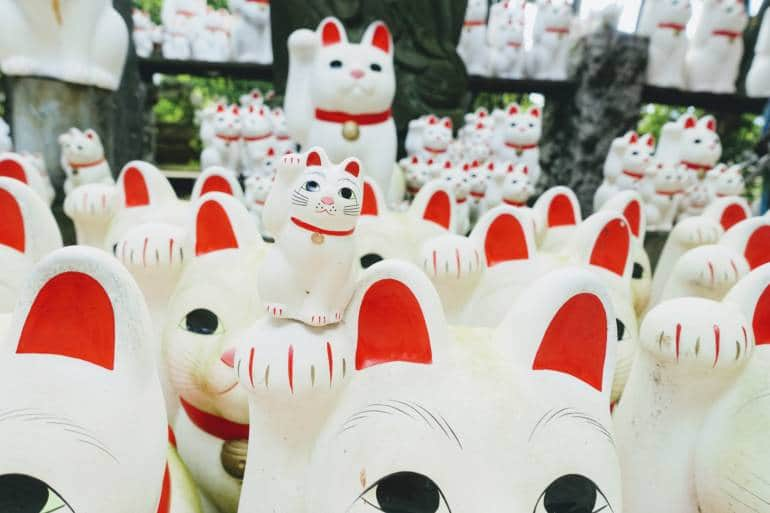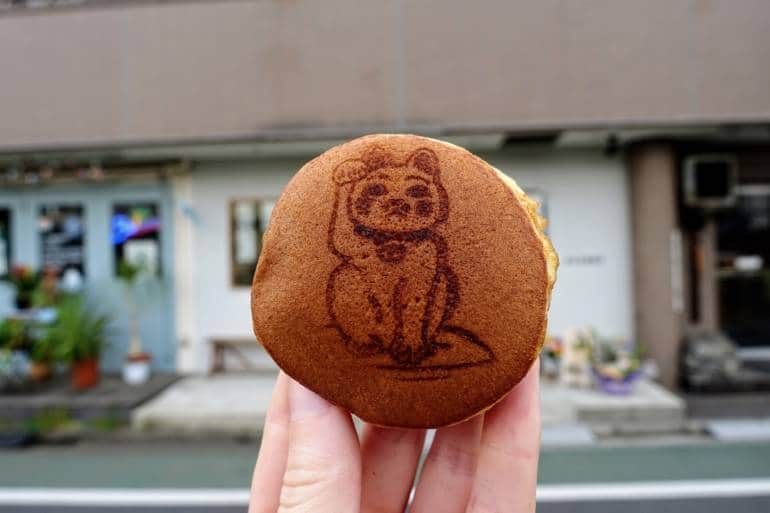Spend an afternoon with the famous lucky cats of Gotokuji and enjoy some delicious food along the way.

Setagaya is a small bubble of laid-back community life in the heart of Tokyo. Mainly served by the Setagaya Tram Line (sometimes decorated as a cat), it’s managed to escape the hustle and bustle of other areas and remains a relaxed haven with independent shops, cafes and pleny of cycling locals. The most famous spot is Gotokuji Temple, known for the lucky waving cat that’s famous throughout the world. If you’re looking for an afternoon out that can only be described as lovely, then this is the one for you.
1. Stroll to sweet potato, dumplings and fika!
Arriving at Gotokuji or Yamashita Station, you’ll find yourself in a pleasantly busy little hub of shops and restaurants, with a straight road to Gotokuji Temple. Along the route, you’ll find plenty of tempting food, from fish flake–topped ramen to a shop dedicated to sweet potato from across Japan. Depending on your hunger levels, we suggest a mini-food tour, starting with a few of the design-your-own dumplings from the trendy Nippon Gyoza (¥500 for 10, English menus available).

A little further along is the Swedish bakery Fika Fabriken—a small cafe filled with authentic homemade cakes. Named after the Swedish tradition of fika—sharing cake and coffee with friends—a perfect afternoon treat. Stylish and minimal, the bakery houses a few seats in the back with a full view of the kitchen area. The deliberations of what to have (we can vouch for the kanelbulle and carrot cake!) will leave you determined to come back for more.

Once you’re feeling decidedly Swedish, you can continue along until you come across a red-bannered shop. Dedicated to Japan’s sweet potato, Fuji is a simple place offering seasonal varieties from throughout the country, including a bright purple option from Miyazaki and the popular anno-imo—a sweet and soft variety from Kagoshima. If you’re here during autumn or winter, you’ll be fighting the locals for these perfectly cooked potatoes, which are available to eat in the small seating area or on the go.
2. Get lucky at Gotokuji Temple

Once you’re thoroughly full and need a bit of a stroll, you can make your way on to the star of the show (kanelbulle aside). A beautiful temple with impressive main hall and a wooden pagoda, Gotokuji would be a nice enough temple to visit, but it’s the cats that make it special.
The story of the lucky cat
As legend has it, the temple was once home to an aging monk who tended to the temple grounds along with his cat, whom he shared everything with. The monk asked that the cat bring them good fortune in return, as times were tough. One summer’s day, five samurai walked into the grounds, having been beckoned by the cat’s wave. After hearing the monk preach, the samurai converted.
One announced that he was the feudal lord of Hikone. He donated rice fields and land to the grounds, turning Gotokuji into his family temple it and making it a grand place of worship. After the fortune-bringing cat passed, the monk blessed its grave and the lucky cat statue soon became a symbol for household serenity, business prosperity and fulfillment of wishes!

There are a few different versions of this story, including one where the feudal lord of Hikone was saved from a storm by the beckoning cat (a bit more dramatic), but we’ve gone with the one offered by the temple staff themselves.
The temple grounds (and its feline inhabitants)
Often looked after by a friendly guide, the temple is spacious and peaceful, with the cats only taking up a small section. You can take your time admiring the buildings and bell tower, as well as relaxing in the courtyard facing the small temple shop.

If you walk past the black lion–topped incense burner, you’ll see the first cat of the day—or will you? Hidden on the pagoda is a little cat statue, but it’s small so you’ll have to look carefully. Once spotted, turn left in front of the main hall and you’ll see the cat-covered ema (a Shinto prayer plaque) covered in the wishes of others. Enter to the smaller temple space and you’ll find the cat-covered shelves to your left.

Admire away, find the cutest little ones balanced on eaves and the weather-aged larger ones guarding the backs. You can add your own cat to the mix from the temple shop (back past the large hall and to the left) from ¥300 for a tiny one and ¥5,000 for an almost real-life one. Apparently, the size of your cat has no influence on your good fortune, so it’s good to know size doesn’t (always) matter.

Once you’ve catted yourself out and taken more photos that you can ever realistically show people, you can head off, good fortune surrounding you like a golden haze.
3. Drop in for dorayaki

On your way back towards Gotokuji, cross the tracks for a stop at the lovely Mahorodou Sougetsu—a contempory Japanese sweet shop. Offering seasonal wagashi (traditional Japanese sweets) that are beautiful as well as delicious, the sweets can be enjoyed with green tea in their cute cafe or taken home for later. Their maneki-neko dorayaki is hard to turn down, but even if you opt for a seasonal sweet they are available to take away too.
4. Soak in a retro sento

While sento are considered far less exciting than onsen, mainly because the water is not heated from a natural hot spring, sometimes they have their own special perks. At Tsurunoyu, they not only use carefully filtered soft water, but they offer a glorious view of Fuji while you bathe. It may not be quite the real thing, but this impressive wall-spanning mural has a wonderfully retro feel to it. With indoor jacuzzi-style baths, and a small outdoor one too, it’s a pretty nice sento to relax in, especially in the colder months. Entry is ¥460 and you’ll need a small towel (or you can rent one).
Feeling beckoned? Getting to Gotokuji
While Miyanosaka is a little closer to the temple on the Setagaya line, Gotokuji may well be easier to reach as it is on the Odakyu Line (next door to the Yamashita tram stop). The journey takes 15 minutes on the Odakyu local service train from Shinjuku and costs ¥190. Or 12 minutes on the Setagaya Line from Sangenjaya, costing the fixed rate of ¥150.
- Places
- Restaurants































